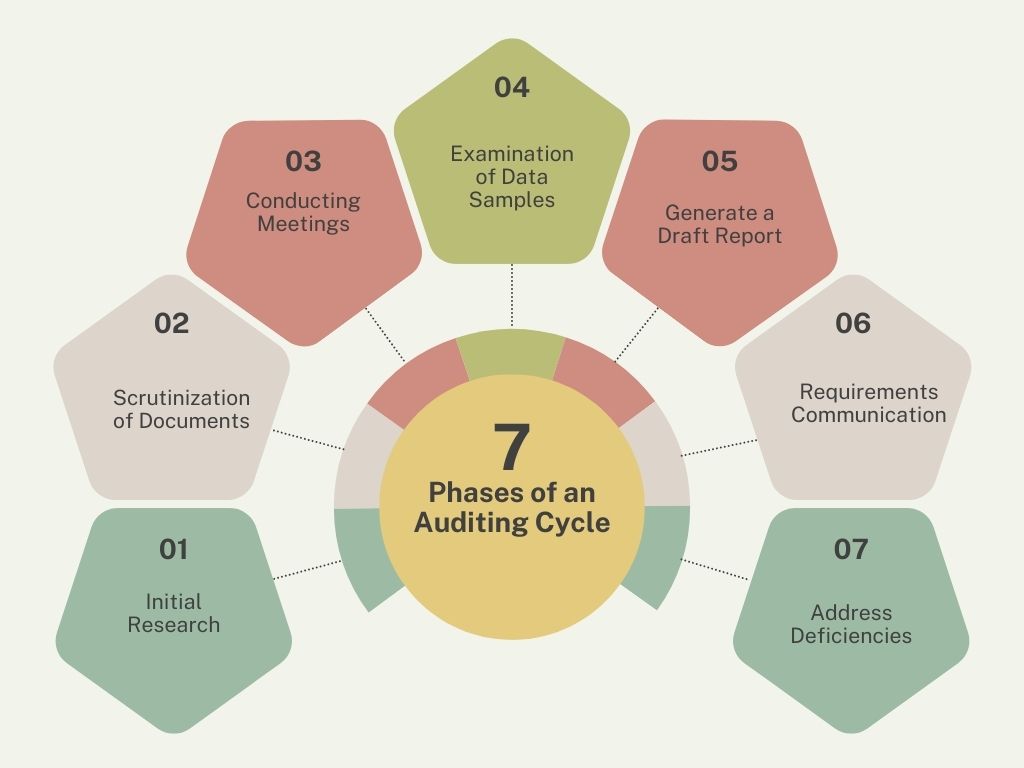What is Auditing?
Auditing is the process of thoroughly examining the financial statements of a company, typically through an independent auditing company, to ascertain fraud, misrepresentation, errors, and omissions and report the relevant findings to the company’s management and the concerned regulatory authority.
As organizations conduct audits for different purposes, the scope and time of each audit may differ. Some audits may be conducted throughout the entire organization. Others may be conducted only at the departmental level. Similarly, the timing of the auditing may also differ such as quarterly, half-yearly, and yearly.
What are the Different Types of Auditing?
The auditing process, by its nature, can be classified into three types: Internal Audit, External Audit, and Government Audit.
1. Internal Audit
Internal Audit is an audit performed within the company by its employees. The reports and findings of the internal audit are generally not disclosed to the public. The objective of conducting such an audit is to aid the management in its decision-making and help them serve the best company interest through accurate knowledge.
- Internal Audit helps develop comprehensive risk management strategies
- Internal Audit helps ensure the accuracy and completeness of the financial records
- Internal Audit helps work towards a common plan for achieving common objectives
2. External Audit
An External Audit is the complete opposite of an Internal Audit. In an external audit, companies disclose their financial statements to an external auditor to seek their unbiased opinion. The objective of conducting external auditing is to detect errors, frauds & discrepancies in the financial statements.
- It is conducted by an independent auditor to check the fairness of the financial statements.
- It enhances the credibility of the company among investors, creditors, and suppliers
- External Auditing helps with the early detection of fraud and ensures the highest adherence
3. Government Audit
A Government Audit is one of the three types of auditing. A common misconception is that Government-initiated tax auditing in accounting is a negative thing, however, it’s not entirely true. Many times, the Government randomly selects companies to identify any misrepresentation in the taxable income declared by them.
- Government bodies use statistical formulas to find potential discrepancies.
- The sole objective is to assess adherence to the strict Government regulations
- Covers different types of auditing such as Performance, Investigative, Compliance, etc.
4. ISO Audit
The International Organization for Standardization (ISO), based in Geneva, has laid down certain standards for companies to follow. ISO Audit is among the main types of audits that assess a company’s compliance with these standards to ensure the products are of utmost quality, and safe for the consumer.
- ISO Audit checks compliance with various quality, environmental, and security standards
- ISO Audit can be conducted by both internal teams as well as external auditors
- Identification of areas of business operations that are non-compliant with corrective measures
5. IT Audit
IT Audit involves a complete evaluation of the company’s IT infrastructure to ensure compliance with safety and regulatory standards. This type of auditing is essential for companies to reduce the risks posed by data breaches, cyber crimes, and hardware failure, among others.
- IT Audit measures the organization’s readiness to respond to data & cyber threats
- Effective identification and mitigation of IT-specific risks
- Encourages adoption of modern technological standards for maximum security
What is the Significance of Auditing for Businesses?
Now that we’ve covered what is an audit and its types, let us discuss what significant benefit it offers to businesses.
1. Increases Stakeholder Confidence
Auditing in accounting serves as a true and fair representation of the company’s financial records. It builds trust, credibility, and confidence among various stakeholders including investors, material suppliers, and customers. It promotes relations with external stakeholders that are based on mutual trust, transparency, and confidence.
2. Fraud Detection
Auditing in accounting plays a critical role in the detection and elimination of fraud. An independent and experienced auditor can discover errors (whether intentional or not) and discrepancies in the various books of accounts. Besides, the auditor can also document the specific weaknesses in the organization’s system that could be exploited for personal benefits.
3. Strict Regulatory Compliance
Auditing in accounting ensures the business stays compliant with the local laws, and regulations. It brings transparency to the business operations and financial records. The business gains stability in its business operations as it adheres to the best industry regulations and follows the best practices. Strict adherence to regulatory aspects reduces the risk of fines, penalties, and legal complications.
4. Better Financial Planning
Another benefit of regular auditing in accounting is better financial planning. The process of auditing involves a thorough examination of all incomes & expenditures, and assets & liabilities. With access to clear and reliable information, the Management gains valuable insights to improve the business performance and achieve the desired targets.
5. Reduces Bottlenecks
Auditing in accounting brings various benefits for the organization, from adhering to the best industry practices to promoting continuous improvements. Reducing bottlenecks in business operations and bringing transparency enables the organization to grow and expand its market base.
What are 7 Phases of an Auditing Cycle?
The process of examining the company’s financial records usually goes through seven phases. Here are those phases:
1. Initial Research
As we’ve already discussed in the what is an audit, the initial planning and research phase in the auditing process involves gathering relevant information. This information may pertain to the company’s books of accounts and the scope of the audit. In this phase, the auditor assesses the operational constraints and develops a comprehensive Audit Plan for auditing the books of accounts. The focus is on ensuring completeness in the auditing process.
2. Scrutinization of Documents
The second phase in auditing involves collecting the financial documents and scrutinizing them for inaccuracies and discrepancies. The auditor makes a preliminary list of receipts, ledgers, bank statements, and minutes of the board meetings. It helps make an unbiased assessment of the business operations throughout the auditing report.
3. Conducting Meetings
Auditing is a two-way process. As such, there is a constant need for face-to-face meetings and communication between the auditing team and the company’s executives. In this stage of auditing, the auditor holds meetings with the senior executives of the company and the Board of Directors (BOD). He discusses an all-comprehensive plan for auditing the books of accounts. He informs them about the pre-decided time frame for the entire auditing process.
4. Examination of Data Samples
Now, the auditor starts examining random transactions from the financial books and analyses them for potential discrepancies. If he is not satisfied with the same, he communicates his decision to the concerned people. The skills and experience of the auditor play an important role during this phase. The auditor’s knowledge and experience can impact the audit report’s depth and quality.
5. Generate a Draft Report
The auditor generates a Draft Report. This report contains complete information about any policy violations, discrepancies, and mismanagement found throughout the auditing process. The auditor lays down several suggestions in the Draft Report. However, they are not binding upon the Management. It is up to the Management to follow them or not.
6. Requirements Communication
Since auditing is a two-way process, the Auditor may frequently require access to additional information pertaining to various financial matters. The auditor informs the Management about the requirement for any additional information. If he is satisfied with the Management’s explanations, he makes adequate changes to the Draft Report. Once the draft report is finalized, it cannot be modified.
7. Address Deficiencies
This is the last phase of the auditing cycle. Based on the auditor’s report, the Management may take several steps such as strengthening the financial health of the company, improving trust & transparency, and bringing better control mechanisms. Auditing helps the organization make remediation plans and take corrective actions.
Difference Between First-Party, Second-Party Party and Third-Party Audits
There is a fundamental difference between the First-party, Second-party, and Third-party Audits in terms of the appointment of the auditor and the ultimate objective of the auditing. Here’s the difference:
| First-party Audit | Second-party Audit | Third-party Audit | |
| Definition | A first-party audit is internally performed by the company’s appointed employee. | A second-party audit is performed by an external party with a direct contractual relationship (such as a vendor or customer) | A third-party audit is performed by an independent auditor appointed by a party with no contractual relationship with the business entity. |
| Objective of Audit | The objective of the first-party audit is to track the performance of internal business functions and ensure compliance with the industry standards | The objective of the second-party audit is to check whether the business complies with the quality standards set up by the vendor or customer. | The objective of the third-party audit is to check whether the business complies with the latest regulatory framework to meet the interests of shareholders & customers. |
| Auditor | The auditor is an internal employee of the company | The auditor is appointed by the vendor or customer | The auditor is a Govt body or an Independent certification authority |
| Control over Auditor | The organization has full control over the Auditor. | The organization has some control over the Auditor (but not entirely). | The organization has no control over the Auditor. |
| Reporting Authority | Board of Directors | Vendor or Customer | Government bodies |
Wrapping Up
With the ever-increasing business transactions and an increasing pace of financial information, it has become incumbent for the shareholders to rely on true and transparent information. Auditing plays a critical role in bringing transparency to the internal financial structure of the organization and promotes a relationship built on trust & confidence.
In addition to contributing to detecting fraudulent business practices, auditing contributes to better financial planning and adherence to the best risk management practices. It promotes a culture of predictive and proactive risk management for the long-term growth of the organization.
FAQs
1. What is the Definition of Audit?
Auditing meaning is that it is an independent analysis of the company’s books of accounts for the purpose of finding anomalies and reporting the same for regulatory and compliance purposes. Auditing in accounting plays an extensive role in making sure the company’s financial statements reflect the true and accurate picture. Auditing helps build trust between the company and external stakeholders (such as investors, vendors, etc.).
2. Do auditors use ERP software?
Yes, auditors often use ERP software as part of their auditing processes. These software systems help auditors access relevant financial data, analyze transactions, and assess internal controls within an organization’s accounting system. Using ERP software can streamline audit procedures and improve the efficiency and accuracy of the audit process.
3. What Role Does an Auditor Play in the Auditing Process?
The auditor is a central figure in the auditing process who drafts a comprehensive audit plan and thoroughly examines the company’s financial records. He performs an independent analysis and outlines his findings, including any errors, omissions, and negligence’s detected, to the company’s management and the state regulatory body.
4. How is a Performance Audit Different from a Compliant Audit?
Performance Auditing is primarily aimed at providing insights into the effectiveness of an organization’s operations. This type of auditing is extremely common in the Government bodies to assess the performance of different schemes and government programs. In contrast, Compliant Auditing performs a thorough analysis of an organization’s operations to meet regulatory & industry requirements and find areas of improvement.
5. When Does a Government Order a Tax Auditing?
A Government or regulatory body may order mandatory tax auditing due to a variety of reasons, such as misrepresentations, frauds, tax omissions, and extraordinarily high charitable donations. Tax Auditing in accounting is performed to extensively check the accuracy of the company’s tax returns and deter potential tax evasion. The Government can, at its sole discretion, order a Tax Auditing.
6. What is the Difference Between Accounting & Auditing?
Accounting is the process of recording financial transactions and compiling financial statements that aid the company’s management with strategic decision-making. They provide crucial insights into the company’s financial health and performance. In contrast, Auditing is the process of checking the accuracy of the financial statements — typically, through an independent auditor, to find discrepancies, errors, and fraudulent practices.







